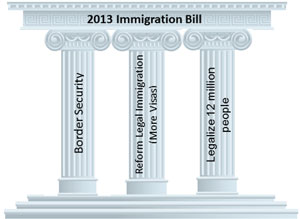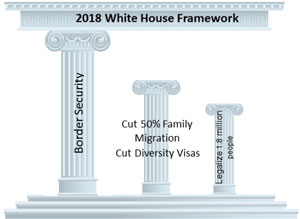There’s been a lot of talk about the White House’s four pillars of immigration reform, a description that suggests a balanced and even-handed approach to tackling the many problems facing our immigration system. Unfortunately, there’s nothing balanced about President Trump’s immigration framework or the Republican proposal introduced by Senator Grassley that attempts to put it into law. Both condition legal status for Dreamers on a series of proposals that would make our immigration system more punitive, less diverse, and less likely to foster growth and innovation.
The White House/Grassley proposal veers from the idea of balance, holding out the prospect for legalization for 1.8 million Dreamers in exchange for billions of dollars in border security enhancements, a fifty per cent reduction in family immigration numbers, broad and punitive changes to interior enforcement, and much more. In fact, the Grassley bill adds even more immigration provisions to the White House framework, leveraging the desperate situation of Dreamers to force a wholesale, negative re-write of immigration law on the public.
On a balance sheet, these proposals extract an extraordinarily high price for legalization of a relatively small group, taking far more than they give.
In past debates over comprehensive immigration reform, massive bills often had lots of pillars, including legalization, visa reform, and border security, but they were much more balanced trade-offs. They were comprehensive bills precisely because they attempted to look at the immigration system as a whole, and each pillar reflected equal parts give and take, enforcement and benefits, contraction and expansion of programs. The Dream Act was one relatively small piece of the legalization pillar and a very small piece of the overall bills, which frequently ran to a thousand pages or more. The trade-offs were genuine trade-offs, not always great or fair, but somewhat balanced. They looked something like this:

If the Senate supports the Grassley bill, the result will be quite different. These pillars are part of a building that cannot stand, because they are so uneven that they will bring the roof down on our heads.
The White House/Grassley bill looks something like this:

There are better, sturdier options. The Dream Act or something that closely resembles it addresses the discrete and immediate concerns of the sub-group of undocumented people that President Trump targeted by ending DACA. These young people, Americans in every way but their place of birth, urgently need a solution that allows them to remain in the United States and to eventually become citizens. The Dream Act itself should be enough, but it seems inevitable that some kind of concession is going to be necessary. A bill proposed by Senators McCain and Coons which combines the principles of the Dream Act with a much more moderate proposal for border security seems to fit the bill.
Act now on Connecting Our World to urge Congress to provide permanent relief for Dreamers
We need many improvements to our immigration system, but they cannot all be fixed in the three days allotted to the immigration debate on the Senate floor this week. Better to build a snug cabin than a rickety hotel; better to genuinely help the Dreamers than to endanger our entire system.
